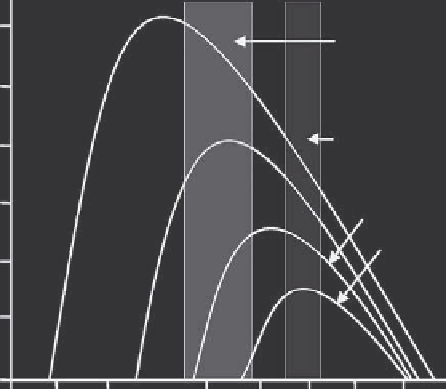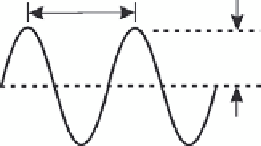Geology Reference
In-Depth Information
14.2. Principles of Remote
Sensing
Suitable for
surface
fire detection
10
6
3000
k
10
5
Suitable for
underground
fire detection
10
4
10
3
1000
k
500
k
300
k
10
2
Illustrated here are the emission
spectra of blackbodies at different
temperatures. Planck's law is the
physical principle guiding how
energy is emitted by high-tempera-
ture objects.
Figure by Anupma Prakash and Rudiger Gens, this work; adapted from Lillesand et al., 2007.
10
1
1
0.1
0.2
0.5
1 2
Wavelength (
5 0 0 0
μ
m)
Electromagnetic Energy and Spectrum
I
n the most fundamental form, remote sensing relies on measuring the amount of energy reaching the sensor after
interacting with the target on the ground and the atmosphere intervening between the target and the sensor
1
.
When this energy, also known as the electromagnetic energy, is in motion it is referred to as electromagnetic
radiation. Electromagnetic radiation can travel in a wavelike form (Figure 14.2.1), even through vacuum, at a
constant speed c (the speed of light).
As it follows a wavelike form, it can be characterized simply by measures such as wavelength
λ
and frequency
f
.
Wavelength and frequency are inversely related according to
c¼f λ
ð
14
:
2
:
1
Þ
All possible wavelengths and frequencies of the electromagnetic radiation constitute the electromagnetic spectrum
(Figure 14.2.2). The electromagnetic spectrum ranges from very short wavelength cosmic rays to the long
wavelength of standard radio waves. The remote sensing sensors record data only in selected discrete wavelength
ranges of the electromagnetic spectrum. These wavelength ranges are often referred to as bands or spectral bands.
Wavelength (
λ
)
Amplitude
Figure 14.2.1. Wavelike form of electromagnetic radiation.
1
For additional information about the interaction of matter and energy (i.e., reflection, scattering, transmission, absorption, and emission), see
Gens (2009) and Lillesand et al. (2007).





